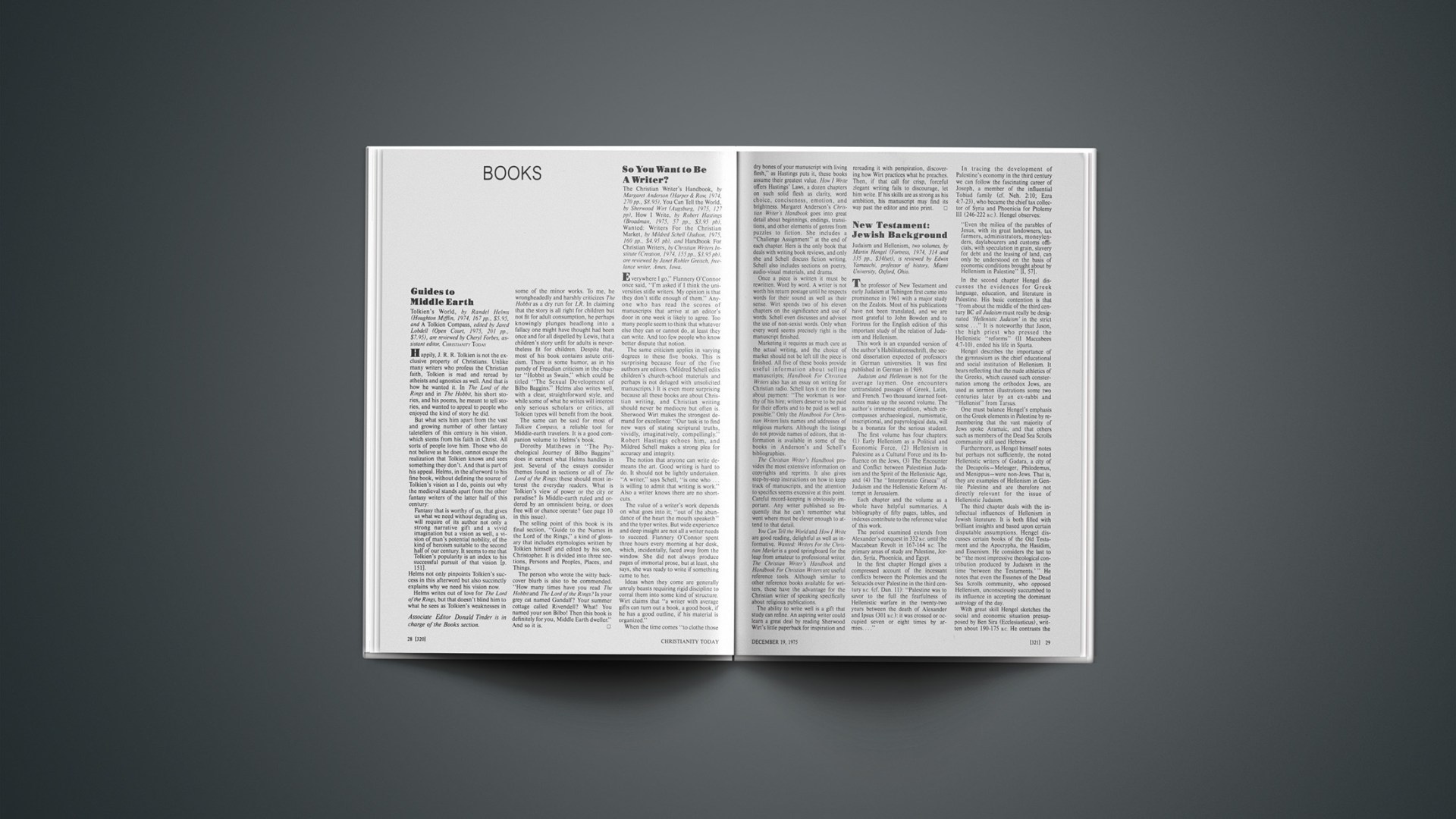Guides To Middle Earth
Tolkien’s World, by Randel Helms (Houghton Mifflin, 1974, 167 pp., $5.95, and A Tolkien Compass, edited by Jared Lobdell (Open Court, 1975, 201 pp., $7.95), are reviewed by Cheryl Forbes, assistant editor, CHRISTIANITYTODAY
Happily, J. R. R. Tolkien is not the exclusive property of Christians. Unlike many writers who profess the Christian faith, Tolkien is read and reread by atheists and agnostics as well. And that is how he wanted it. In The Lord of the Rings and in The Hobbit, his short stories, and his poems, he meant to tell stories, and wanted to appeal to people who enjoyed the kind of story he did.
But what sets him apart from the vast and growing number of other fantasy taletellers of this century is his vision, which stems from his faith in Christ. All sorts of people love him. Those who do not believe as he does, cannot escape the realization that Tolkien knows and sees something they don’t. And that is part of his appeal. Helms, in the afterword to his fine book, without defining the source of Tolkien’s vision as I do, points out why the medieval stands apart from the other fantasy writers of the latter half of this century:
Fantasy that is worthy of us, that gives us what we need without degrading us, will require of its author not only a strong narrative gift and a vivid imagination but a vision as well, a vision of man’s potential nobility, of the kind of heroism suitable to the second half of our century. It seems to me that Tolkien’s popularity is an index to his successful pursuit of that vision [p. 151].
Helms not only pinpoints Tolkien’s success in this afterword but also succinctly explains why we need his vision now.
Helms writes out of love for The Lord of the Rings, but that doesn’t blind him to what he sees as Tolkien’s weaknesses in some of the minor works. To me, he wrongheadedly and harshly criticizes The Hobbit as a dry run for LR. In claiming that the story is all right for children but not fit for adult consumption, he perhaps knowingly plunges headlong into a fallacy one might have thought had been once and for all dispelled by Lewis, that a children’s story unfit for adults is nevertheless fit for children. Despite that, most of his book contains astute criticism. There is some humor, as in his parody of Freudian criticism in the chapter “Hobbit as Swain,” which could be titled “The Sexual Development of Bilbo Baggins.” Helms also writes well, with a clear, straightforward style, and while some of what he writes will interest only serious scholars or critics, all Tolkien types will benefit from the book.
The same can be said for most of Tolkien Compass, a reliable tool for Middle-earth travelers. It is a good companion volume to Helms’s book.
Dorothy Matthews in “The Psychological Journey of Bilbo Baggins” does in earnest what Helms handles in jest. Several of the essays consider themes found in sections or all of The Lord of the Rings; these should most interest the everyday readers. What is Tolkien’s view of power or the city or paradise? Is Middle-earth ruled and ordered by an omniscient being, or does free will or chance operate? (see page 10 in this issue).
The selling point of this book is its final section, “Guide to the Names in the Lord of the Rings,” a kind of glossary that includes etymologies written by Tolkien himself and edited by his son, Christopher. It is divided into three sections, Persons and Peoples, Places, and Things.
The person who wrote the witty back-cover blurb is also to be commended. “How many times have you read The Hobbit and The Lord of the Rings? Is your grey cat named Gandalf? Your summer cottage called Rivendell? What! You named your son Bilbo! Then this book is definitely for you, Middle Earth dweller.” And so it is.
So You Want To Be A Writer?
The Christian Writer’s Handbook, by Margaret Anderson (Harper & Row, 1974, 270 pp., $8.95), You Can Tell the World, by Sherwood Wirt (Augsburg, 1975, 127 pp), How I Write, by Robert Hastings (Broadman, 1975, 57 pp., $3.95 pb), Wanted: Writers For the Christian Market, by Mildred Schell (Judson, 1975, 160 pp., $4.95 pb), and Handbook For Christian Writers, by Christian Writers Institute (Creation, 1974, 155 pp., $3.95 pb), are reviewed by Janet Rohler Greisch, free-lance writer, Ames, Iowa.
Everywhere I go,” Flannery O’Connor once said, “I’m asked if I think the universities stifle writers. My opinion is that they don’t stifle enough of them.” Anyone who has read the scores of manuscripts that arrive at an editor’s door in one week is likely to agree. Too many people seem to think that whatever else they can or cannot do, at least they can write. And too few people who know better dispute that notion.
The same criticism applies in varying degrees to these five books. This is surprising because four of the five authors are editors. (Mildred Schell edits children’s church-school materials and perhaps is not deluged with unsolicited manuscripts.) It is even more surprising because all these books are about Christian writing, and Christian writing should never be mediocre but often is. Sherwood Wirt makes the strongest demand for excellence: “Our task is to find new ways of stating scriptural truths, vividly, imaginatively, compellingly.” Robert Hastings echoes him, and Mildred Schell makes a strong plea for accuracy and integrity.
The notion that anyone can write demeans the art. Good writing is hard to do. It should not be lightly undertaken. “A writer,” says Schell, “is one who … is willing to admit that writing is work.” Also a writer knows there are no shortcuts.
The value of a writer’s work depends on what goes into it; “out of the abundance of the heart the mouth speaketh” and the typer writes. But wide experience and deep insight are not all a writer needs to succeed. Flannery O’Connor spent three hours every morning at her desk, which, incidentally, faced away from the window. She did not always produce pages of immortal prose, but at least, she says, she was ready to write if something came to her.
Ideas when they come are generally unruly beasts requiring rigid discipline to corral them into some kind of structure. Wirt claims that “a writer with average gifts can turn out a book, a good book, if he has a good outline, if his material is organized.”
When the time comes “to clothe those dry bones of your manuscript with living flesh,” as Hastings puts it, these books assume their greatest value. How I Write offers Hastings’ Laws, a dozen chapters on such solid flesh as clarity, word choice, conciseness, emotion, and brightness. Margaret Anderson’s Christian Writer’s Handbook goes into great detail about beginnings, endings, transitions, and other elements of genres from puzzles to fiction. She includes a “Challenge Assignment” at the end of each chapter. Hers is the only book that deals with writing book reviews, and only she and Schell discuss fiction writing. Schell also includes sections on poetry, audio-visual materials, and drama.
Once a piece is written it must be rewritten. Word by word. A writer is not worth his return postage until he respects words for their sound as well as their sense. Wirt spends two of his eleven chapters on the significance and use of words. Schell even discusses and advises the use of non-sexist words. Only when every word seems precisely right is the manuscript finished.
Marketing it requires as much care as the actual writing, and the choice of market should not be left till the piece is finished. All five of these books provide useful information about selling manuscripts; Handbook For Christian Writers also has an essay on writing for Christian radio. Schell lays it on the line about payment: “The workman is worthy of his hire; writers deserve to be paid for their efforts and to be paid as well as possible.” Only the Handbook For Christian Writers lists names and addresses of religious markets. Although the listings do not provide names of editors, that information is available in some of the books in Anderson’s and Schell’s bibliographies.
The Christian Writer’s Handbook provides the most extensive information on copyrights and reprints. It also gives step-by-step instructions on how to keep track of manuscripts, and the attention to specifics seems excessive at this point. Careful record-keeping is obviously important. Any writer published so frequently that he can’t remember what went where must be clever enough to attend to that detail.
You Can Tell the World and How I Write are good reading, delightful as well as informative. Wanted: Writers For the Christian Market is a good springboard for the leap from amateur to professional writer. The Christian Writer’s Handbook and Handbook For Christian Writers are useful reference tools. Although similar to other reference books available for writers, these have the advantage for the Christian writer of speaking specifically about religious publications.
The ability to write well is a gift that study can refine. An aspiring writer could learn a great deal by reading Sherwood Wirt’s little paperback for inspiration and rereading it with perspiration, discovering how Wirt practices what he preaches. Then, if that call for crisp, forceful elegant writing fails to discourage, let him write. If his skills are as strong as his ambition, his manuscript may find its way past the editor and into print.
New Testament: Jewish Background
Judaism and Hellenism, two volumes, by Martin Hengel (Fortress, 1974, 314 and 335 pp., $34/set), is reviewed by Edwin Yamauchi, professor of history, Miami University, Oxford, Ohio.
The professor of New Testament and early Judaism at Tubingen first came into prominence in 1961 with a major study on the Zealots. Most of his publications have not been translated, and we are most grateful to John Bowden and to Fortress for the English edition of this important study of the relation of Judaism and Hellenism.
This work is an expanded version of the author’s Habilitationsschrift, the second dissertation expected of professors in German universities. It was first published in German in 1969.
Judaism and Hellenism is not for the average laymen. One encounters untranslated passages of Greek, Latin, and French. Two thousand learned footnotes make up the second volume. The author’s immense erudition, which encompasses archaeological, numismatic, inscriptional, and papyrological data, will be a bonanza for the serious student.
The first volume has four chapters: (1) Early Hellenism as a Political and Economic Force, (2) Hellenism in Palestine as a Cultural Force and its Influence on the Jews, (3) The Encounter and Conflict between Palestinian Judaism and the Spirit of the Hellenistic Age, and (4) The “Interpretatio Graeca” of Judaism and the Hellenistic Reform Attempt in Jerusalem.
Each chapter and the volume as a whole have helpful summaries. A bibliography of fifty pages, tables, and indexes contribute to the reference value of this work.
The period examined extends from Alexander’s conquest in 332 B.C. until the Maccabean Revolt in 167–164 B.C. The primary areas of study are Palestine, Jordan, Syria, Phoenicia, and Egypt.
In the first chapter Hengel gives a compressed account of the incessant conflicts between the Ptolemies and the Seleucids over Palestine in the third century B.C. (cf. Dan. 11): “Palestine was to savor to the full the fearfulness of Hellenistic warfare in the twenty-two years between the death of Alexander and Ipsus (301 B.C): it was crossed or occupied seven or eight times by armies.…”
In tracing the development of Palestine’s economy in the third century we can follow the fascinating career of Joseph, a member of the influential Tobiad family (cf. Neh. 2:10; Ezra 4:7–23), who became the chief tax collector of Syria and Phoenicia for Ptolemy III (246–222 B.C.). Hengel observes:
“Even the milieu of the parables of Jesus, with its great landowners, tax farmers, administrators, moneylenders, daylabourers and customs officials, with speculation in grain, slavery for debt and the leasing of land, can only be understood on the basis of economic conditions brought about by Hellenism in Palestine” [I, 57].
In the second chapter Hengel discusses the evidences for Greek language, education, and literature in Palestine. His basic contention is that “from about the middle of the third century BC all Judaism must really be designated ‘Hellenistic Judaism’ in the strict sense …” It is noteworthy that Jason, the high priest who pressed the Hellenistic “reforms” (2 Maccabees 4:7–10), ended his life in Sparta.
Hengel describes the importance of the gymnasium as the chief educational and social institution of Hellenism. It bears reflecting that the nude athletics of the Greeks, which caused such consternation among the orthodox Jews, are used as sermon illustrations some two centuries later by an ex-rabbi and “Hellenist” from Tarsus.
One must balance Hengel’s emphasis on the Greek elements in Palestine by remembering that the vast majority of Jews spoke Aramaic, and that others such as members of the Dead Sea Scrolls community still used Hebrew.
Furthermore, as Hengel himself notes but perhaps not sufficiently, the noted Hellenistic writers of Gadara, a city of the Decapolis—Meleager, Philodemus, and Menippus—were non-Jews. That is, they are examples of Hellenism in Gentile Palestine and are therefore not directly relevant for the issue of Hellenistic Judaism.
The third chapter deals with the intellectual influences of Hellenism in Jewish literature. It is both filled with brilliant insights and based upon certain disputable assumptions. Hengel discusses certain books of the Old Testament and the Apocrypha, the Hasidim, and Essenism. He considers the last to be “the most impressive theological contribution produced by Judaism in the time ‘between the Testaments.’ ” He notes that even the Essenes of the Dead Sea Scrolls community, who opposed Hellenism, unconsciously succumbed to its influence in accepting the dominant astrology of the day.
With great skill Hengel sketches the social and economic situation presupposed by Ben Sira (Ecclesiasticus), written about 190–175 B.C. He contrasts the latter’s confidence in divine retribution in the present with the rise of the apocalyptic interpretation that expected an imminent end to history.
More controversial are his ready assumptions of Hellenistic dates for Koheleth (Ecclesiastes), Job 28, Proverbs 1–9, and Daniel. (On the latter see my Greece and Babylon, Baker, 1967, and D. J. Wiseman, et al., Notes on Some Problems in the Book of Daniel, Tyndale [London], 1965.) Quite speculative is his suggestion that the personified Wisdom of Proverbs 8 was created by the transference to Wisdom of the attributes of Isis-Astarte by Jewish wisdom schools in the third century B.C.
In his final chapter Hengel interprets the outbreak of the Maccabean Revolt by following Bickermann’s thesis, “that the impulse to the most extreme escalation of events in Judea came from the extreme Hellenists in Jerusalem itself” But this presupposes that Jason, Menelaus, and the Tobiads had a calculated program to transform the Jewish state into a Greek polis so as to overcome the separation between the Jews and the rest of the Hellenistic world.
Such an interpretation has been criticized by other scholars, such as Tcherikover. In my view, it gives far too much credit to the Hellenist Jews, who may have simply been interested in power and position, and it hardly does justice to the role of Antiochus Epiphanes, the Seleucid ruler who authorized the anti-Jewish measures that precipitated the revolt.
Hengel concludes that the reaction against these Hellenists led to the later Jewish exaltation of the Torah, which in turn made it difficult for the Jews to accept Christianity with its emphasis upon Christ rather than the Torah.
However one may differ with the author in particulars, one will be indebted to him for his brilliant and provocative study. Without doubt this is one of the most important studies of the intertestamental period, if not the most important one, to appear in our generation.
Fuzzy View Of Love
Dimensions of Love: East and West, by James Mohler (Doubleday, 1975, 392 pp., $9.95), is reviewed by Robert Brow, associate rector, Little Trinity Anglican Church, Toronto, Ontario.
If you want quotations about love from all the main Eastern and Western religions, plus Plato, Ovid, Dante, Freud, and the Jewish Kabbalah, try Mohler’s book. My difficulty with it is that the result is a string of unrelated beads. There is a minimum of analysis, criticism, or classification. It is as if someone were to produce a supposedly scientific work on plants and animals by collecting those that have blue as part of their coloration. The situation is even worse when the common element is a word with a vast imprecision of meaning. What would one find in common between the love of an S.S. man for his Fuehrer, the Good Samaritan’s love, and “I love Bach”? And the uses of the word “love” in religion can cover anything from fertility cults, sacred prostitution, and the lusts of Greek gods to Gnosticism.
Chapter eight has a collection of quotations from Ovid’s love poems, then parts of Ovid’s Art of Love and his Remedies of Love. Now, it makes sense to collect and compare love poems and love songs. You could also compare Ovid’s seduction manual with the Kama Sutra and the many modern examples of the genre. What you cannot do is to suggest that in moving from falling in love, to seduction, and then to Plotinus and Augustine in the next chapter you are dealing with the same topic.
In chapter 4 the Kama Sutra is grouped with several quite different forms of Hindu bhakti, and the author asks, What is the relation between them? The answer should have been, None whatever, apart from the use of the word “love” in both. The Kama gives us techniques for catching and holding another by means of sex. Bhakti is the relationship of a worshiper to his god. Mohler could have used Rudolph Otto’s classic book on Bhakti, India’s Religion of Grace, and Christianity: Compared and Contrasted (1930) to indicate some of the vital contrasts that need to be made between the different schools of Hindu bhakti and the Christian faith. There could have been comparisions with devotion to Buddha in Mahayana Buddhism and the love of God in Islamic Sufism. There we can find points of contact. What I question is the juxtaposition of “love” in a Hindu sex manual, love for Krishna, and the homosexual relation between philosopher and pupil in Plato’s Symposium, and the consequent suggestion that all these illuminate a true Christian view of love for God and man.
Admittedly the author tries to excuse himself from the rigorous critical task of making distinctions and evaluations. He claims in the prologue that he wishes merely “to present different views and let the reader make his own comparisons and parallels.” But by suggesting comparisons between incomparables he promotes theological confusion.
The key to his own theology is his rejection of Nygren’s distinction between two forms of love in Agape and Eros (1937). Mohler’s only argument against Nygren is a quotation from D. Morgan’s Love: Plato, the Bible and Freud (1964), which he takes to be authoritative. He then asks the good question, “What is the difference between Christian, Jewish, and Platonic views of love?,” but in one brief unsatisfactory page he confuses the answer. He claims that eros is as much of divine origin as agape, which is true, and that “the ascending view of love had added much to the growth of mysticism in Christianity, Judaism, and Islam,” which is also true. But the conclusion we are to draw is the false idea that the New Testament agape from God for sinners, which then flows out in love for the brethren and the world, is after all only another form of the Greek eros. Mohler fails to see what Nygren clarified so well, that agape loves regardless of the goodness of the object, whereas eros loves only the beautiful, the pleasing, the self-gratifying.
In panning this book am I merely reflecting my own theological stance? Obviously I do assume that neither manuals for sexual conquest, nor Krishna’s affairs with the milkmaids, nor the seduction of beautiful boys to impart philosophy, has anything to do with a truly Christian experience of God. I also assume that all forms of devotion that begin with man’s desires, as opposed to the unmerited grace of God, are fundamentally mistaken. I am convinced that comparative religion must insist on making careful distinctions instead of assuming that all religions are somehow doing the same thing in the general direction of the same God. I take it that Mohler either rejects my assumptions or refused to make his views plain.
Perhaps Dimensions of Love should be viewed by an impartial observer as a brilliant work of Christian syncretism. The syncretism suggested is much greater than the old assumption that all religions somehow relate to the same God. Here we have the love for gods and men in all religions linked to the whole of what our modern world calls sexuality. Human love in whatever dimension illumines and is illuminated by love for whatever one cares to worship. That is a very modern and extremely appealing notion. As Mohler points out from selected texts in the Old Testament and the New, one could make a case for saying the view is biblical.
The author’s method is also very modern. You avoid logical distinctions and theological clarity, avoid or dismiss all contrary views, and arrive at your end by letting the reader become entangled in his own confusion. That is what worries me. The book is thoroughly bad theology by my standards, but I have a feeling it will be hailed as liberating in all seminaries of the new syncretism.
Mohler is a Jesuit. If he represents the current trend of thinking in his order, the right arm of Rome has moved a long, long way from the Council of Trent. The trouble is that the new confusion seems to me far far more perilous for the Church than the old bigotry.










